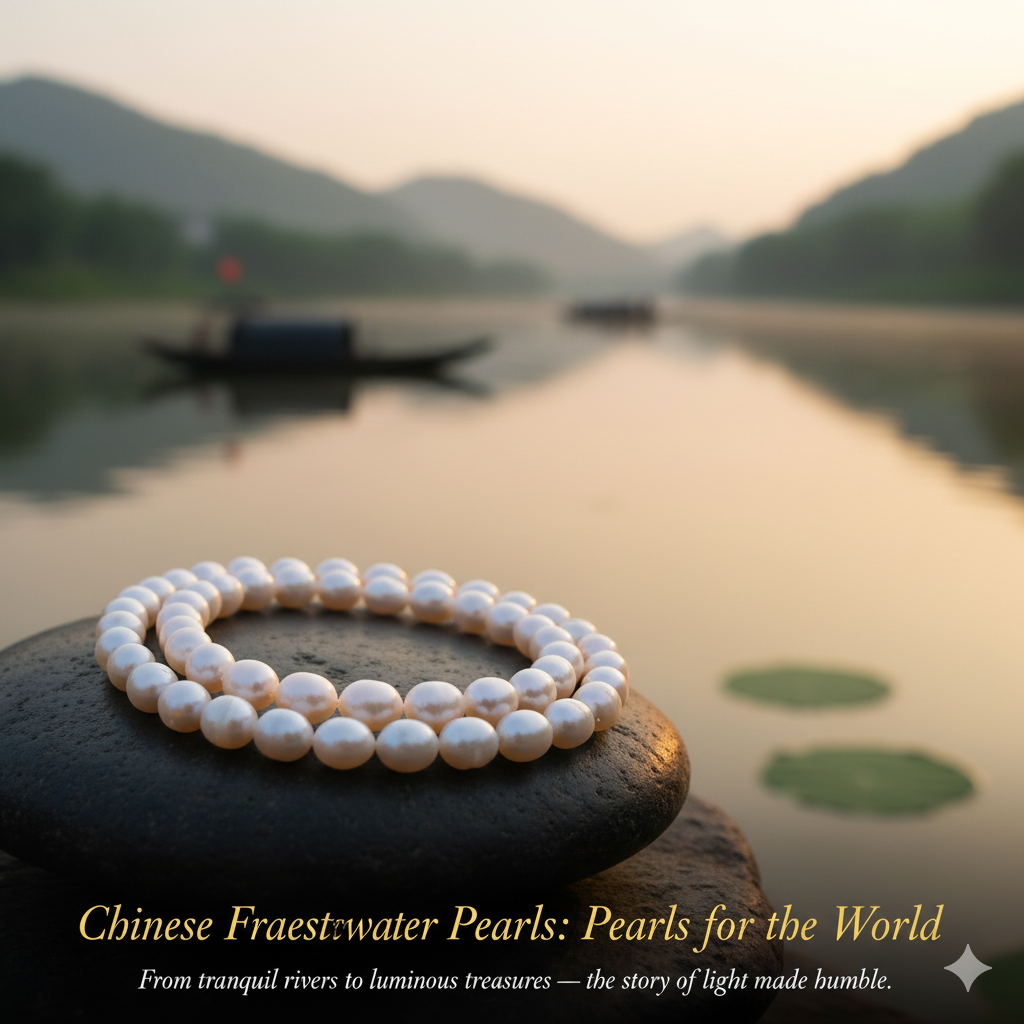Introduction
1) The River That Learned to Shine
Not all beauty is born of oceans.
Some arises in still water — patient, silent, filled with life unseen.
In the lowland lakes of China, where willows bend over water and mornings smell of rain, an invisible revolution began.
Here, in ponds and rivers once used for carp and lotus, the freshwater pearl emerged — a marvel not of opulence but of quiet abundance.
Today, nearly 95 percent of the world’s pearls come from these Chinese waters. Yet their story is not about mass production; it is about the democratization of light — how a nation turned humble rivers into fields of radiance.
2) Origins — The Ancient Memory
China’s relationship with pearls dates back over two thousand years.
Records from the Han Dynasty mention natural freshwater pearls from rivers near Huai and Yangtze.
Back then, divers collected them from wild Hyriopsis and Cristaria mussels, offering them to emperors as tributes of purity.
But harvesting was brutal and random; for every few pearls, thousands of mussels perished.
For centuries, pearls remained the privilege of royalty.
That would change in the 20th century, when science, patience, and the resilience of rural communities converged.
3) The Birth of Cultured Freshwater Pearls
In the 1960s, researchers in Zhejiang and Hubei provinces began experimenting with tissue-nucleated mussels.
Unlike saltwater oysters that require a round bead, freshwater mussels can produce pearls using only a tiny piece of donor mantle tissue — no bead, no nucleus.
Each mussel could yield 20–40 pearls, turning lakes into living treasure vaults.
The first generations were uneven — rice-shaped and pastel — but they glowed with sincerity.
By the 1980s, the innovation spread to Suzhou, Zhenjiang, and Changde, where families tended ponds like orchards.
These were not factories; they were micro-ecosystems — a new partnership between man and water.
4) Lake Taihu — The Cradle of Modern Freshwater Pearls
Of all pearl regions, Lake Taihu near Suzhou became legendary.
Its mineral balance, moderate temperature, and shallow calm made it ideal for Hyriopsis cumingii, the triangle shell mussel.
By the 1990s, “Biwa-style pearls from China” began to rival their Japanese ancestors — but with gentler sheen and a wider colour palette.
Japan’s Biwa Lake had once led the world, but industrial pollution ended its era.
China quietly inherited the mantle — not by imitation, but by evolution.
Lake Taihu’s farmers, many of them multi-generational cultivators, learned to grade water by sight, to sense nacre quality by touch, and to harvest by lunar cycle.
Their work turned handicraft into heritage.
5) How They Are Formed
Freshwater pearls grow inside large mussels that can host multiple grafts.
Technicians insert tiny pieces of mantle tissue from a donor mussel into the host’s shell.
Over 2–6 years, the mussel secretes aragonite crystals and conchiolin, layer by layer, until a pearl forms.
Because there is no bead nucleus, these pearls are often oval or baroque — but entirely nacre.
That purity gives them rich depth and soft diffusion of light, similar to natural pearls.
Modern refinement techniques allow single-nucleation, creating near-round shapes, but the philosophy remains unchanged: patience is the craft.
6) The Spectrum of Colour
Chinese freshwater pearls possess an unmatched variety of hues — their secret beauty.
| Shade | Common Name | Tone Description |
|---|---|---|
| White | Classic | Pure with rosé overtone |
| Pink / Peach | Romantic | Warm pastel like sunrise on silk |
| Lavender / Lilac | Rare | Cool violet glow resembling moonlight |
| Cream / Champagne | Mature | Soft golden undertone |
| Metallic Silver | Modern | High-reflect urban elegance |
These colours occur naturally, depending on mussel type, mineral content, and water chemistry.
No other pearl origin offers such an honest range of tones without artificial dyeing.
7) Shape and Texture
Freshwater pearls have liberated design from geometry.
They come in round, button, drop, oval, potato, baroque, and coin shapes — each with its own poetry.
Coin and baroque pearls in particular have become signatures of contemporary Chinese jewelry — flat, lustrous, and full of personality.
Their surfaces reflect not perfection but intimacy — light as touch, not as mirror.
8) The Economics of Grace
By the early 2000s, China’s freshwater industry matured into a symphony of craft and commerce.
Lakes around Zhenjiang, Hubei, and Anhui hosted hundreds of family-run farms.
Government research centres standardized water quality, while cooperatives handled sorting, polishing, and export.
These pearls began appearing in Tokyo, Bangkok, Hong Kong, and New York, bridging couture and affordability.
They allowed millions to experience genuine pearls without elitism — a revolution in luxury accessibility.
But even at volume, the process remained profoundly human: cleaning mussels by hand, diving by season, sorting by lamplight.
9) The Rise of Near-Round Freshwater Pearls
Technological innovation in the 2010s introduced bead-nucleated hybrids like the Edison and Ming pearls — larger (up to 15 mm) and near-round yet still cultured in freshwater.
Their thick nacre rivals South Sea pearls, their colours more varied.
This blend of tradition and progress redefined China’s reputation: no longer just quantity, but quality and creativity.
10) Comparisons — How Freshwater Differs
| Type | Water | Size Range | Colour | Luster | Price Profile |
|---|---|---|---|---|---|
| Akoya | Salt | 5–9 mm | White/Rose | High mirror | Premium |
| South Sea | Salt | 9–20 mm | White/Gold | Soft silk | Luxury |
| Tahitian | Salt | 8–17 mm | Black/Peacock | Metallic | Luxury |
| Freshwater | River / Lake | 3–15 mm | Multicolour | Velvety glow | Accessible |
Freshwater pearls have a gentler luster — more diffuse, less mirror-sharp — which gives them a distinctly human warmth.
11) The Art of Matching
Because each freshwater pearl varies in hue and shape, matching them for necklaces or earrings is a meditative process.
A single strand may take weeks to assemble — balancing tone, size, and orient.
Experienced stringers describe it as “listening to the pearls until they agree.”
The result is not mechanical uniformity but visual harmony — a strand that feels alive and balanced, like music.
12) Environmental Harmony
Unlike mining or coral extraction, pearl farming in China improves water quality.
Mussels are natural filters, each cleansing 30–50 gallons of water daily.
Healthy farms maintain oxygen balance and support fish and plankton populations.
Many regions — notably in Hubei and Anhui — now run eco-certified farms, where pearl harvesting and biodiversity protection coexist.
In this sense, every Chinese freshwater pearl is also an environmental statement: beauty that heals.
13) The People Behind the Light
In villages around Zhejiang and Anhui, generations live by the rhythm of the water.
Women clean mussels by hand, men dive for inspection, children string the first necklaces after school.
For many families, pearls are not commodities but companions — markers of seasons and sustenance.
Their labor is measured in time, not machines; their reward is light.
14) Modern Design and Global Presence
Today, freshwater pearls are everywhere — in Dior earrings, Chanel brooches, and independent artisan studios alike.
Designers love their fluidity — they pair with minimal metals as well as organic textures.
They’ve moved from traditional round strands to contemporary forms — layered chains, shoulder length drops, asymmetrical baroque arrangements.
In many ways, they’ve become the most emotionally honest gem of the 21st century — luxury without distance.
15) How to Buy Wisely
When choosing freshwater pearls:
- Observe luster. Look for depth and soft reflection, not glass-like shine.
- Check surface. Minor texture is normal; deep pitting reduces grade.
- Confirm colour. Natural tones fade gradually from pearl to pearl — avoid perfectly uniform dye jobs.
- Ask for origin. Lake Taihu and Zhejiang pearls hold prestige.
- String quality. Silk or nylon thread with knots between pearls prevents abrasion.
16) Care and Preservation
- Wear them often — skin moisture keeps pearls radiant.
- Avoid perfume, hairspray, and chlorinated water.
- Wipe gently after wear.
- Store flat in soft cloth pouches, never airtight.
- Restring every year if used frequently.
Freshwater pearls age gracefully; their tones mellow with time like antique silk.
17) Symbolism — Purity with Compassion
In Chinese culture, pearls symbolize truth, benevolence, and enlightenment.
Freshwater pearls extend that symbolism to the everyday — a reminder that grace belongs to those who live simply.
They stand for honest work, steady faith, and the light of ordinary goodness.
At PreciousCarats, we see them as the most human of pearls — gentle in price, rich in soul.
18) Closing — Pearls for the World
From a village pond to a Paris runway, the journey of Chinese freshwater pearls is a journey of light finding its way home.
They are pearls of people, not palaces — evidence that beauty can be abundant without being cheap, and humble without being lesser.
They remind us that the extraordinary is often quiet — growing beneath the surface of ordinary days, layer by layer, until it learns to shine.

